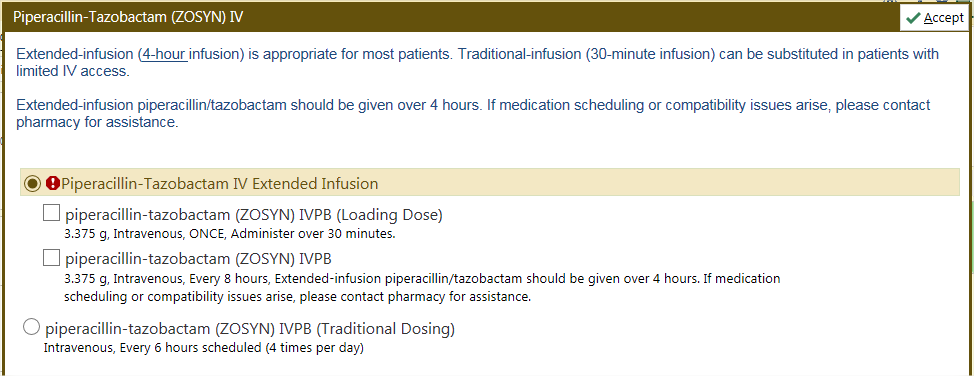Extended-Infusion Piperacillin/tazobactam is Coming Soon
At UMMC, we have successfully piloted extended-infusion (EI) with meropenem over the past several months and are now expanding EI to piperacillin/tazobactam on September 11, 2019. Extended-infusion is a way to optimize the pharmacokinetics/pharmacodynamics of beta-lactam antibiotics, including piperacillin/tazobactam, cefepime, and meropenem.
Several published studies have demonstrated a mortality benefit when EI is utilized, and this infusion strategy has been implemented in many academic medical centers and community hospitals across the United States.
Extended-infusion is recommended for most patients, but patients can be exempted from receiving extended infusion if they meet the following exclusion criteria:
- Patients admitted to the emergency department, OR, PACU, and ambulatory areas
- Medication scheduling and/or drug compatibility conflicts that cannot be resolved without placing additional lines
- Patients with fluid restriction that will not allow for extra volume (~150 ml/day)
Similar to EI meropenem, the switch to EI piperacillin/tazobactam will only affect the adult medical floors and ICU tower, NOT pediatrics.
The recommended dosing for extended-infusion piperacillin/tazobactam can be found in the table below. Please take note of the differences compared with traditional infusion, including dosing frequency and renal dose adjustments.
Table 1: EI Piperacillin/tazobactam dosing recommendations
Drug | Indication | Est CrCl (ml/min) | Extended-infusion dosing |
Piperacillin-tazobactam | General | <20 incl. PD and HD | 3.375 g q12h over 4 hours |
>20 | 3.375 g q8h over 4 hours | ||
Infections caused by organisms with high MICs (>16 mg/L), Pseudomonas aeruginosa, or dosing in cystic fibrosis patients | <20 incl. PD and HD | 4.5 g q12h over 4 hours | |
>20 | 4.5 g q8h over 4 hours | ||
Patients receiving CRRT | All CRRT flow rates | 3.375 g q8h over 4 hours |
A screenshot of the order panel is below. The extended-infusion maintenance dose will be the default. When extended-infusion is chosen, you will have the option to give a loading dose (LD) or start the medication without an LD.
An LD should be considered in patients presenting with sepsis or septic shock, and the maintenance dose should be initiated 4 hours after the loading dose is given in this patient population. For patients who are not presenting in sepsis or septic shock, and who have received a one-time dose in the ED, the maintenance dose can be scheduled with the normal dosing interval (8 hours after the initial dose).
If you need assistance with ordering, or have questions regarding extended-infusion, please contact your unit-based pharmacist or antimicrobial stewardship. You can reach the antimicrobial stewardship team at asp@umc.edu, or extension 5-2722/5-2721.



